Feature Publication Archive
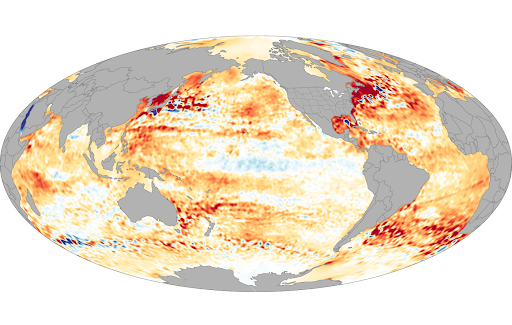
This map shows heat content anomalies (differences from the long-term average)—in the top 700 meters (~2,100 feet) of the global ocean. Positive anomalies mean the ocean gained heat in 2020 (orange); negative anomalies mean the ocean lost heat energy (blue) in 2020. NOAA Climate.gov image, based on data provided by John Lyman (UH JIMAR/PMEL)
Johnson, G.C., and R. Lumpkin (2021): Overview. In State of the Climate in 2020, Global Oceans. Bull. Am. Meteorol. Soc., 102 (8), S149–S150, https://doi.org/10.1175/ BAMS-D-21-0083.1.
Johnson, G.C., J.M. Lyman, T. Boyer, L. Cheng, J. Gilson, M. Ishii, R.E. Killick, and S.G. Purkey (2021): Ocean heat content. In State of the Climate in 2020, Global Oceans. Bull. Am. Meteorol. Soc., 102 (8), S156–S159, https://doi.org/10.1175/ BAMS-D-21-0083.1.
Johnson, G.C., J. Reagan, J.M. Lyman, T. Boyer, C. Schmid, and R. Locarnini (2021): Salinity. In State of the Climate in 2020, Global Oceans. Bull. Am. Meteorol. Soc., 102 (8), S159–S164, https://doi.org/10.1175/ BAMS-D-21-0083.1.
Alin, S.R., A.U. Collins, B.R. Carter, and R.A. Feely (2021): Ocean acidification status in Pacific Ocean surface seawater in 2020. In State of the Climate in 2020, Global Oceans. Bull. Am. Meteorol. Soc., 102 (8), S184–S185, https://doi.org/10.1175/ BAMS-D-21-0083.1.
Feely, R.A., R. Wanninkhof, P. Landschützer, B.R. Carter, J.A. Triñanes, and C. Cosca (2021): Global ocean carbon cycle. In State of the Climate in 2020, Global Oceans. Bull. Am. Meteorol. Soc., 102 (8), S185–S190, https://doi.org/10.1175/ BAMS-D-21-0083.1.
Tamsitt, V., S. Bushinsky, Z. Li, M. du Plessis, A. Foppert, S. Gille, S. Rintoul, E. Shadwick, A. Silvano, A. Sutton, S. Swart, B. Tilbrook, and N.L. Williams (2021): Southern Ocean. In State of the Climate in 2020. Bull. Am. Meteorol. Soc., 102 (8), S341–S345, https://doi.org/10.1175/BAMS-D-21-0081.1.
The 31st annual State of the Climate report confirmed that several markers such as sea level, ocean heat content, and permafrost in 2020 once again broke records set just one year prior. 2020 was also among the three warmest years in records dating to the mid-1800s, even with a cooling La Niña influence in the second half of the year. New high temperature records were set across the globe.
The report found that the major... more »
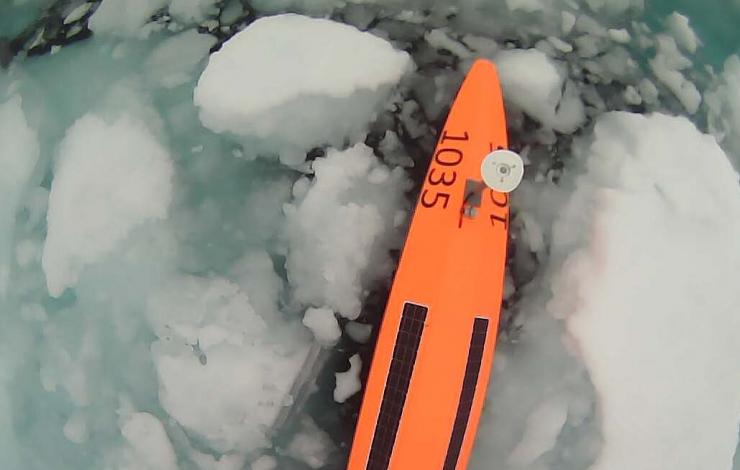
Downward-looking image taken atop the saildrone wing while in sea ice in 2019 mission (Photo Credit: Saildrone Inc.)
Chiodi AM, Zhang C, Cokelet ED, Yang Q, Mordy CW, Gentemann CL, Cross JN, Lawrence-Slavas N, Meinig C, Steele M, Harrison DE, Stabeno PJ, Tabisola HM, Zhang D, Burger EF, O’Brien KM and Wang M (2021) Exploring the Pacific Arctic Seasonal Ice Zone With Saildrone USVs. Front. Mar. Sci. 8:640690. doi: 10.3389/fmars.2021.640697
A recent study published in Frontiers in Marine Science identified navigational challenges and opportunities for Arctic study using saildrones. Researchers from NOAA and other affiliates were among those carrying out the mission, where they took five saildrones to the US Arctic to test their remote navigation capabilities in close proximity to ice, while also collecting data to advance our understanding of Arctic weather, climate, and ecosystems. They then compared existing methods and products for remote sea ice... more »
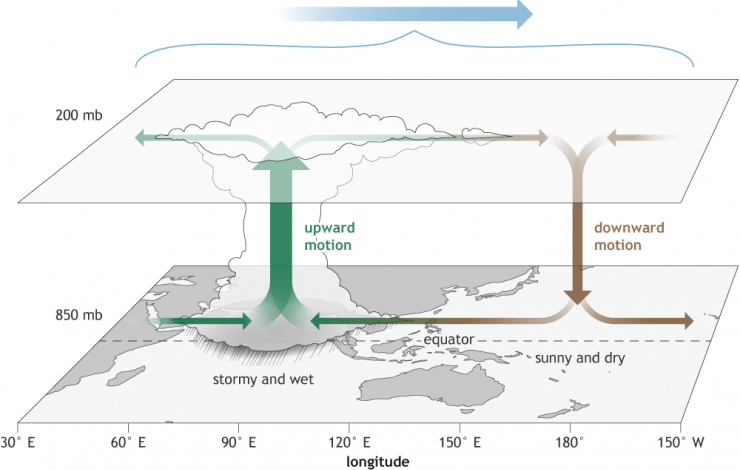
MJO Schematic showing the eastward moving disturbance of clouds, rainfall, winds, and pressure that circles the planet in the tropics and returns to its points of origin in 30 to 60 days, on average. Read the full description on climate.gov.
Zhang, C. (PMEL), A. Adames, B. Khouidar, B. Wang, and D. Yang (2020): Four theories of the Madden-Julian Oscillation. Rev. Geophys., 58(3), e2019RG000685. https://doi.org/10.1029/2019RG000685
The Madden-Julian Oscillation (MJO) is the leading intraseasonal (20–100 days) variability in the tropics. It affects many weather-climate phenomena globally. Tremendous progress has been made in observing, describing, simulating, understanding, and forecasting the MJO since its first documentation in the early 1970s. In particular, theoretical understanding of the MJO has flourished during the past decade or two, with very diverse ideas on the fundamental components of MJO dynamics.
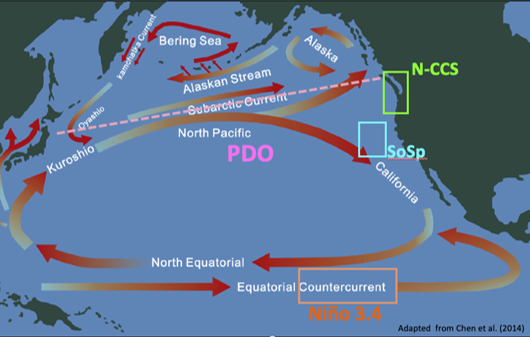
Large-scale drivers of subsurface variability in the Northern California Current System (N-CCS). Adapted from Chen et al. (2014). Click on image for larger map.
Ray, S., S.A. Siedlecki, M.A. Alexander, N.A. Bond, and A.J. Hermann (2020): Drivers of subsurface temperature variability in the Northern California Current. J. Geophys. Res., 125(8), e2020JC016227. https://doi.org/10.1029/2020JC016227
The Washington/Oregon shelf, embedded in the Northern California Current System, is a productive habitat with important commercial fisheries. One of the most valuable species is Dungeness crab, which resides on the subsurface shelf and is sensitive to near‐bottom ocean properties such as temperatures and oxygen concentrations. The predictability of these properties on seasonal time scales is being investigated using J‐SCOPE (JISAO's Seasonal Coastal Ocean Prediction of the Ecosystem), developed at the University of Washington’s Cooperative Institute for Climate, Ocean and Ecosystem Studies... more »
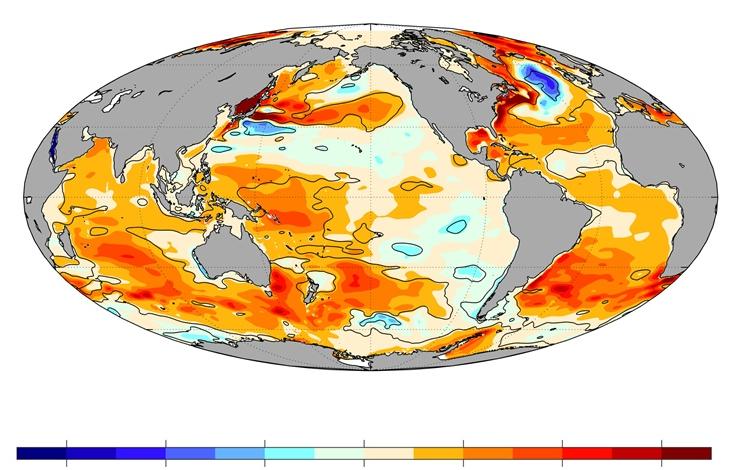
Upper-ocean heat content anomaly linear trends for 1993–2019. Annual estimates of the PMEL combined maps. Values are in W m-2 (colour bar) applying 90% two-tailed (5–95%) confidence limits to outline areas with trends that are statistically significantly different from zero (black contours). Latitudes are gridded at 30° intervals, and longitudes, centered on 150 °W, at 60° intervals (dotted lines). OHCA, ocean heat content anomaly.
Johnson, G.C., and J.M. Lyman, 2020: Warming trends increasingly dominate Global Ocean. Nature Clim. Change, 10, 757–761. https://doi.org/10.1038/s41558-020-0822-0
Ocean warming absorbs about 9/10th of the excess energy that is entering Earth’s climate system because of a build-up of man-made greenhouse gasses in the atmosphere. That warming causes ocean expansion, contributing to sea level rise. Knowing how much, and where the ocean is warming is vital for validating climate models, predicting climate change, assessing sea level rise, and understanding changing marine ecosystems.
Johnson and Lyman (2020) analyze over 15 years of near-global, high-quality, in situ ocean temperature measurements from the Argo array coupled with other historical... more »


